 |
||
|
HOME
|
US Navy -
ships
|
US Navy - air
units
|
USMC - air
units
|
International
Navies
|
Weapon Systems
|
Special Reports |
||
|
US Navy - Aircraft Carrier CVN 76 - USS Ronald Reagan |
||
|
||
| 04/25 | ||
|
Type, class:
Aircraft Carrier - CVN; Nimitz class Builder: Newport News Shipbuilding, Newport News, Virginia, USA STATUS: Awarded: December 8, 1994 Laid down: February 12, 1998 Launched: March 10, 2001 Commissioned: July 12, 2003 IN SERVICE Homeport: Naval Base Kitsap, Bremerton, Washington Namesake: Ronald W. Reagan (1911-2004), 40th President of the USA Ships Motto: PEACE THROUGH STRENGHT Technical Data: see: INFO > Nimitz class Aircraft Carrier - CVN |
||
|
Deployments / Carrier Air Wings embarked / major maintenance periods: May 2004 - July 2004 with Carrier Air Wing 11 (CVW-11) - Norfolk to San Diego via Cape Horn January 2006 - July 2006 with Carrier Air Wing 14 (CVW-14) - Pacific Ocean, Persian Gulf January 2007 - April 2007 with Carrier Air Wing 14 (CVW-14) - Pacific Ocean May 2007 - October 2007: Planned Incremental Availability (PIA) at Naval Base San Diego, California May 2008 - November 2008 with Carrier Air Wing 14 (CVW-14) - Pacific Ocean, Arabian Sea May 2009 - October 2009 with Carrier Air Wing 14 (CVW-14) - Pacific Ocean, Arabian Sea November 2009 - May 2010: Planned Incremental Availability (PIA) at Naval Base San Diego, California June 2010 - August 2010 with Carrier Air Wing 14 (CVW-14) - Pacific Ocean, exercise RIMPAC 2010 February 2011 - September 2011 with Carrier Air Wing 14 (CVW-14) - Pacific Ocean, Centcom AOR January 2012 - March 2013: Drydocking Planned Incremental Availability (DPIA) at Puget Sound Naval Shipyard, Washington June 2014 - August 2014 with Carrier Air Wing 2 (CVW-2) - Pacific Ocean, exercise RIMPAC 2014 September 2014 - April 2015: Planned Incremental Availability (PIA) at Naval Base Coronado, California October 2015 - May 2024 permanently forward deployed to Fleet Activities Yokosuka, Japan with Carrier Air Wing 5 (CVW-5) assigned May 2024 - July 2024: returning to USA / arriving at NAS North Island, San Diego, California on July 23, 2024 departing NAS North Island, San Diego, California on August 10, 2024 arriving at Naval Base Kitsap, Washington on August 13, 2024 |
||
| images | ||
 Naval Base Kitsap, Washington - February 2025  Naval Base Kitsap, Washington - January 2025 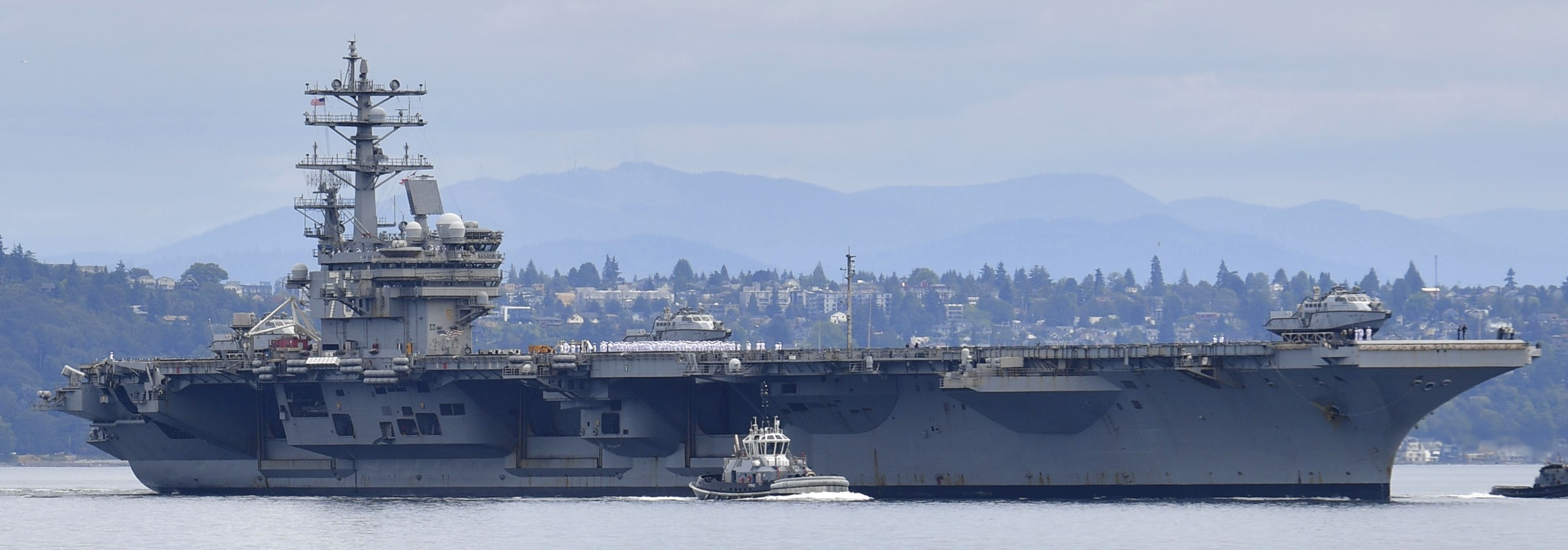 arriving at Naval Base Kitsap, Washington - August 13, 2024  arriving at Naval Base Kitsap, Washington - August 13, 2024 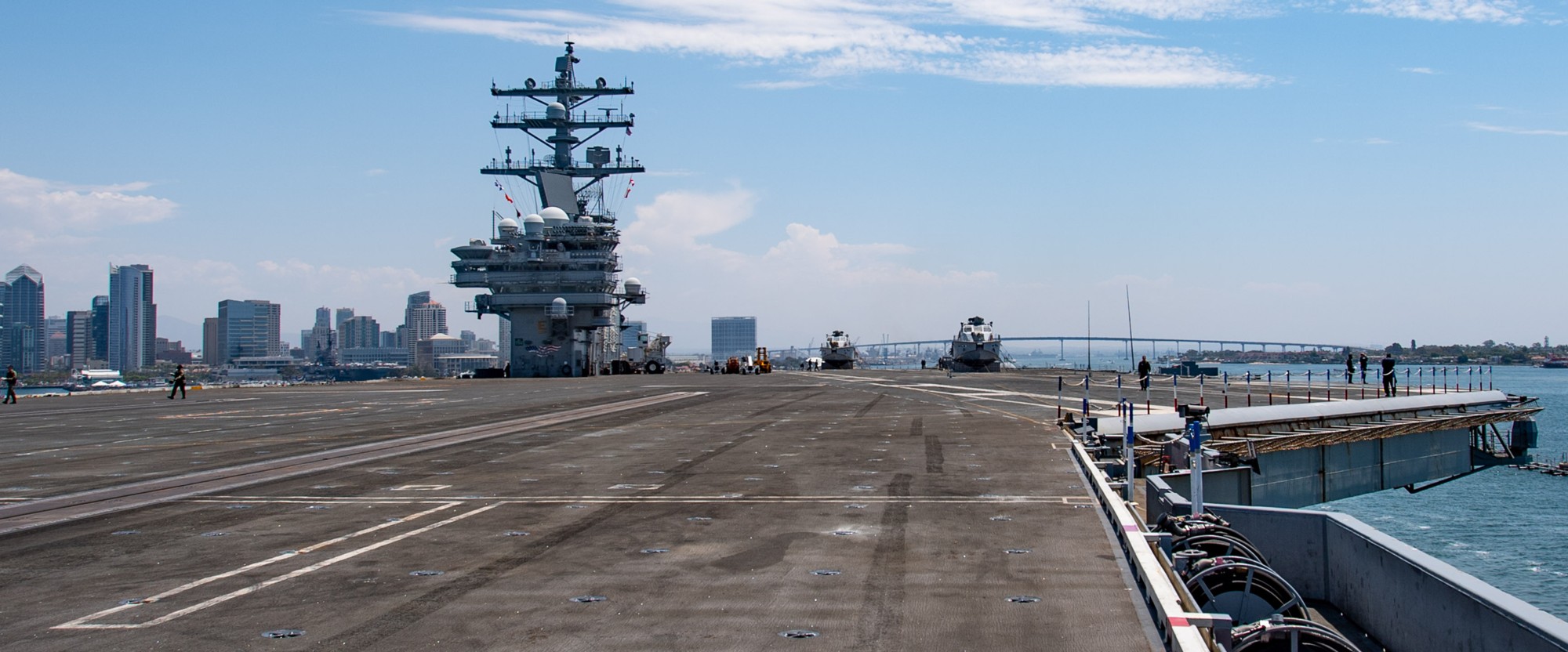 departing Naval Air Station North Island, California - August 10, 2024 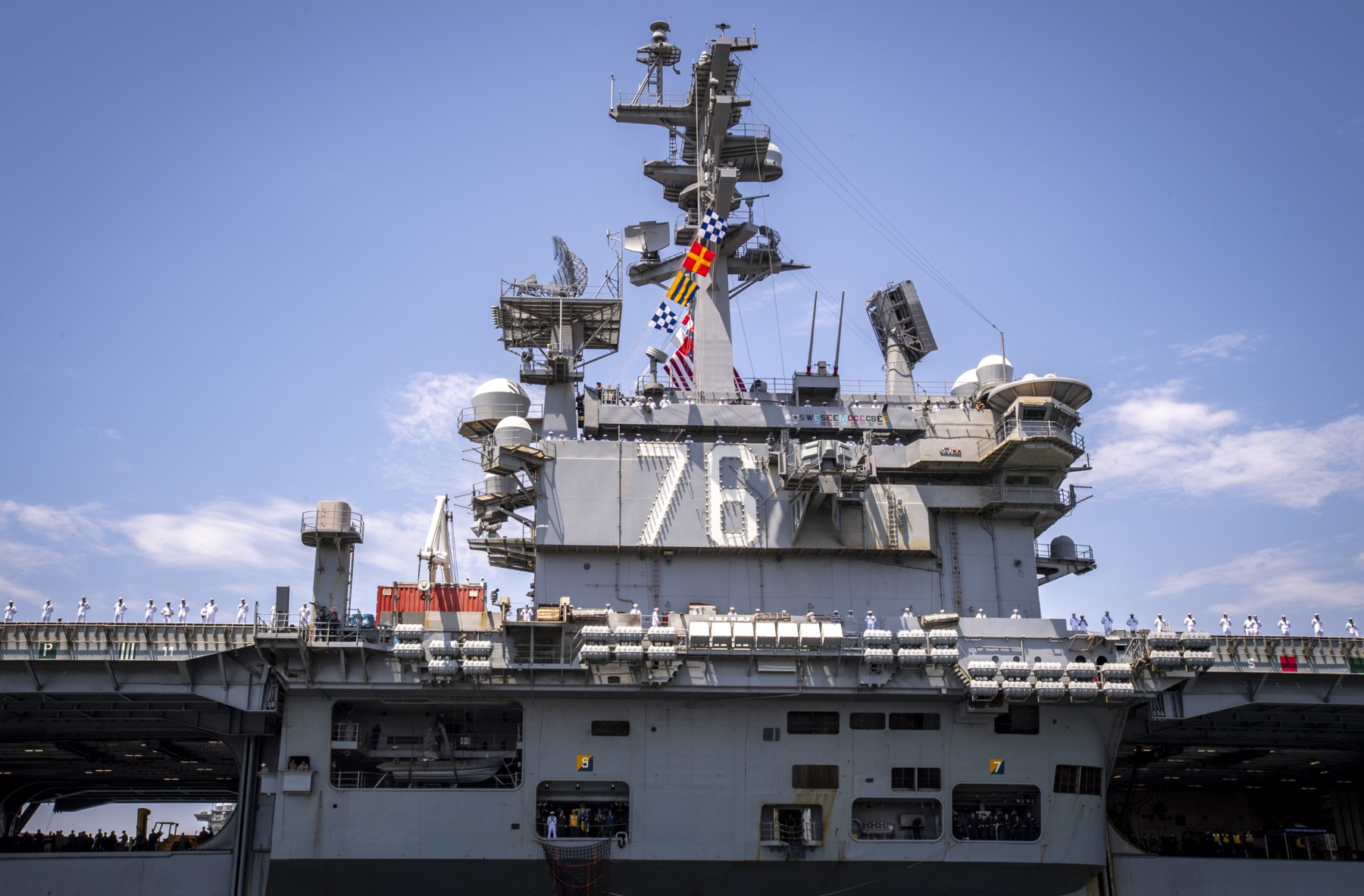 USS Ronald Reagan (CVN 76) arrives at Naval Air Station North Island, California on July 23, 2024  USS Ronald Reagan (CVN 76) arrives at Naval Air Station North Island, California on July 23, 2024. Ronald Reagan and crew are in the process of completing a homeport change, with USS George Washington (CVN 73) replacing the carrier as the forward-deployed US Naval Forces Japan aircraft carrier at Fleet Activities Yokosuka, Japan.  Naval Magazine Indian Island, Washington - July 18, 2024 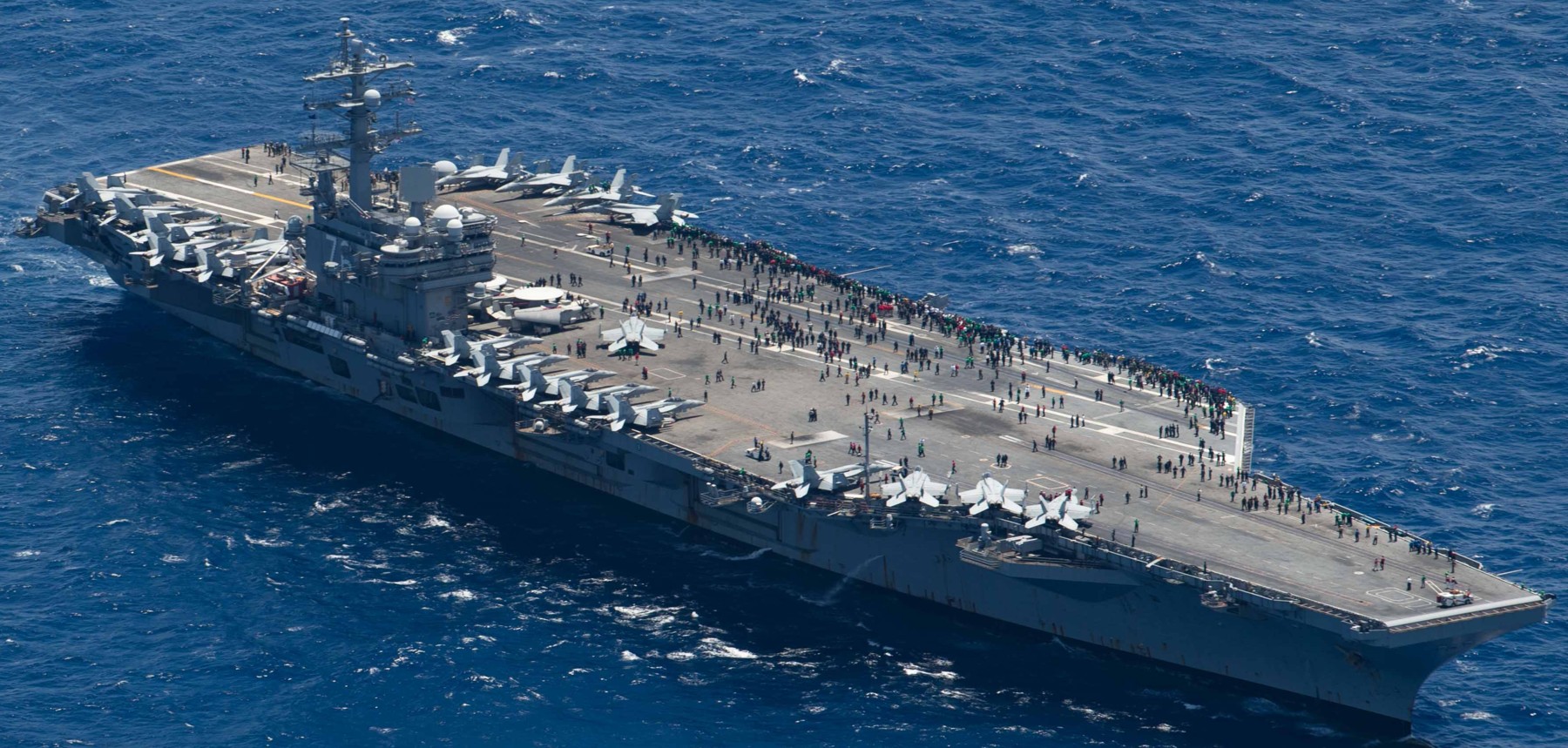 Pacific Ocean - July 2024 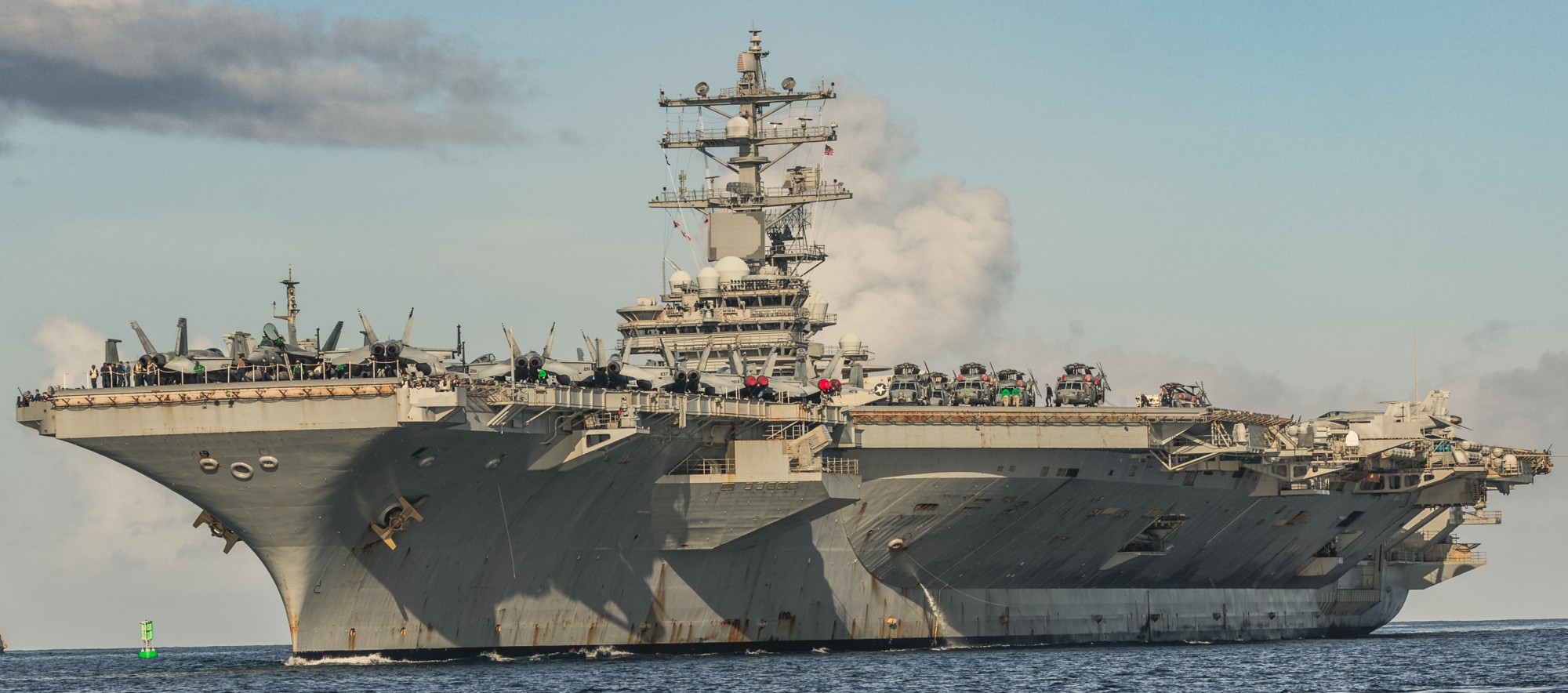 with CVW-5 embarked - Apra Harbor, Guam - June 2024  with CVW-5 embarked - Exercise Valiant Shield - Philippine Sea - June 2024 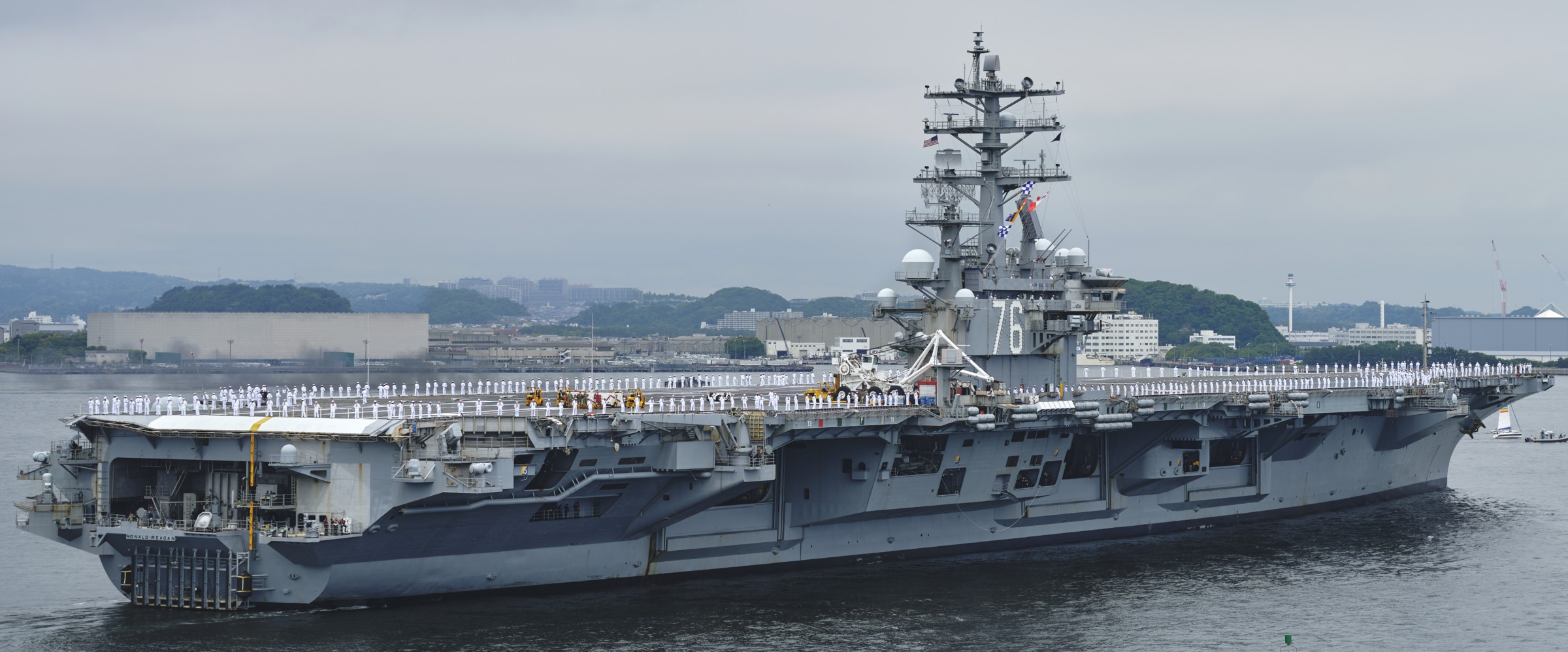 departing Commander, Fleet Activities Yokosuka, Japan for the last time, after completing a hull swap with USS George Washington (CVN 73) - May 16, 2024 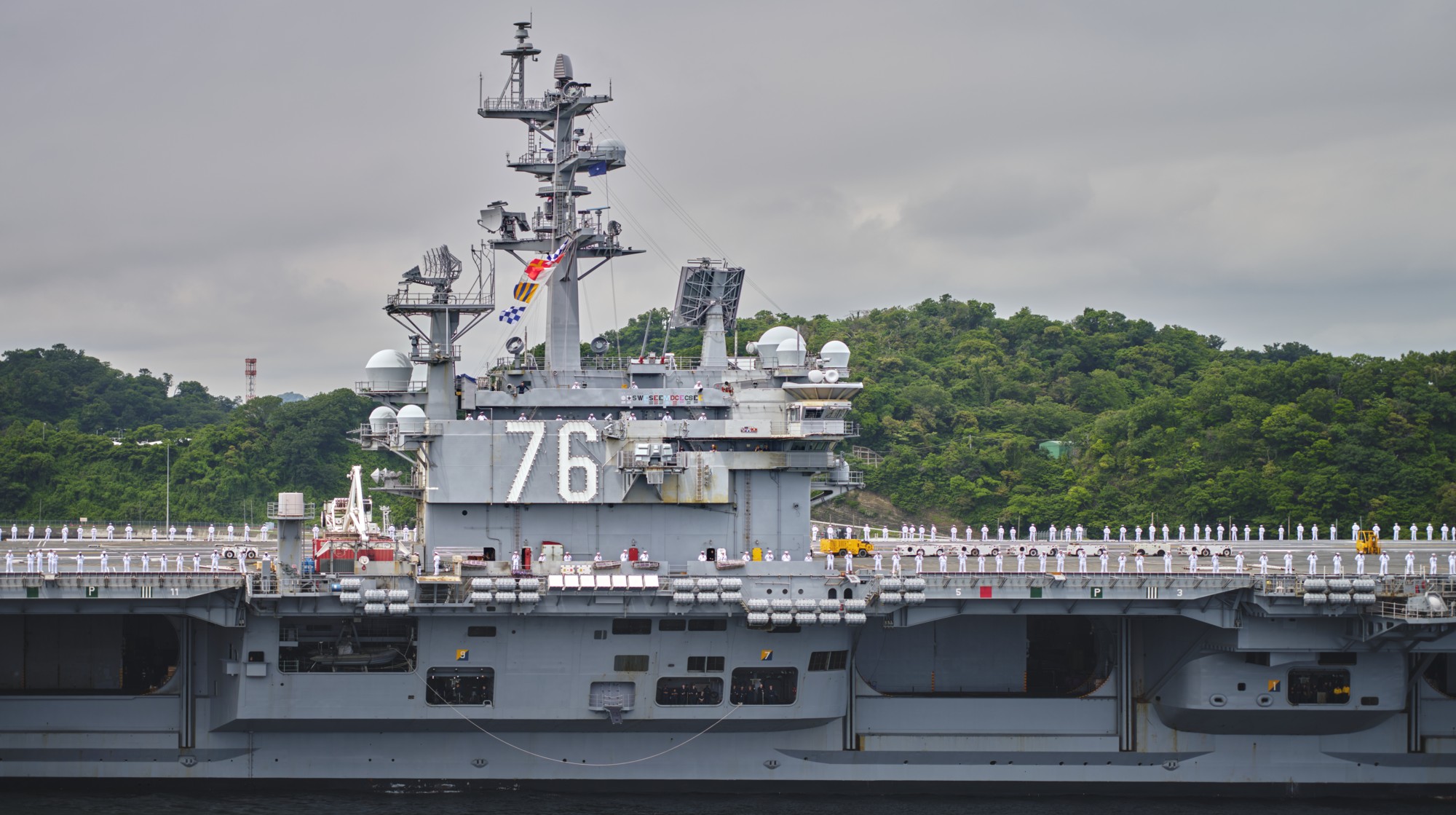 departing Commander, Fleet Activities Yokosuka, Japan for the last time, after completing a hull swap with USS George Washington (CVN 73) - May 16, 2024 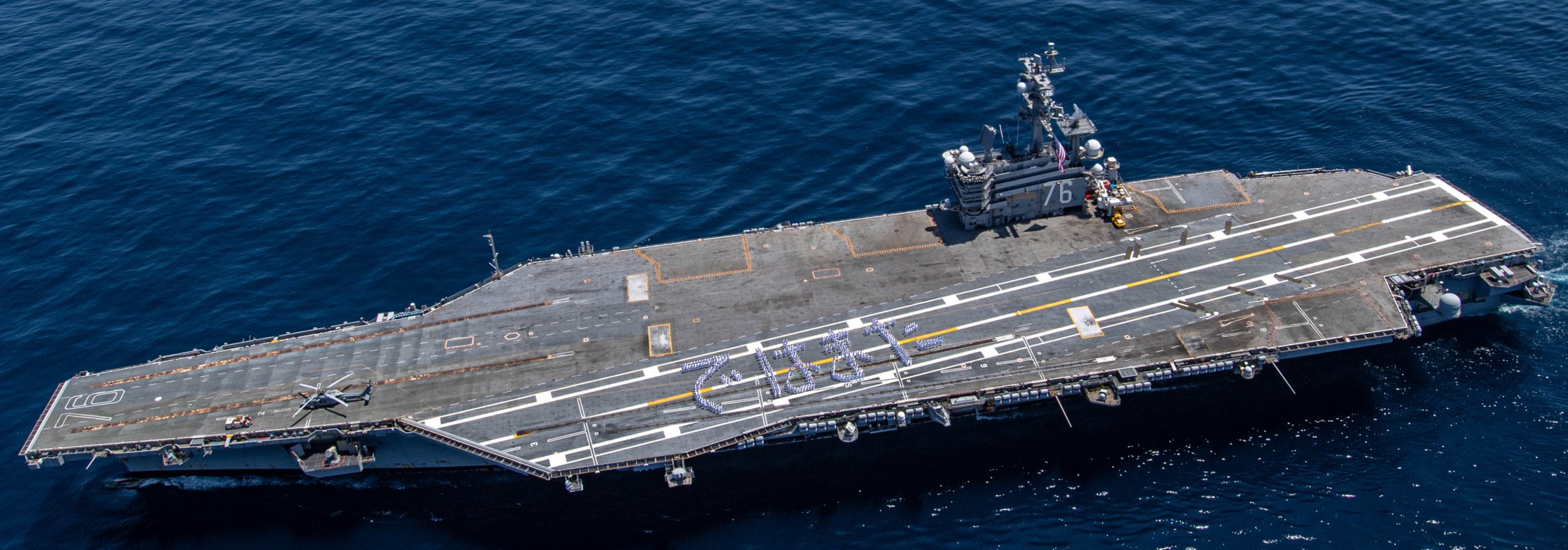 Sailors form Japanese hiragana characters spelling “dewa mata,” which translates to “see you again,” on the flight deck USS Ronald Reagan (CVN 76), in the Tokyo Inlet - May 10, 2024 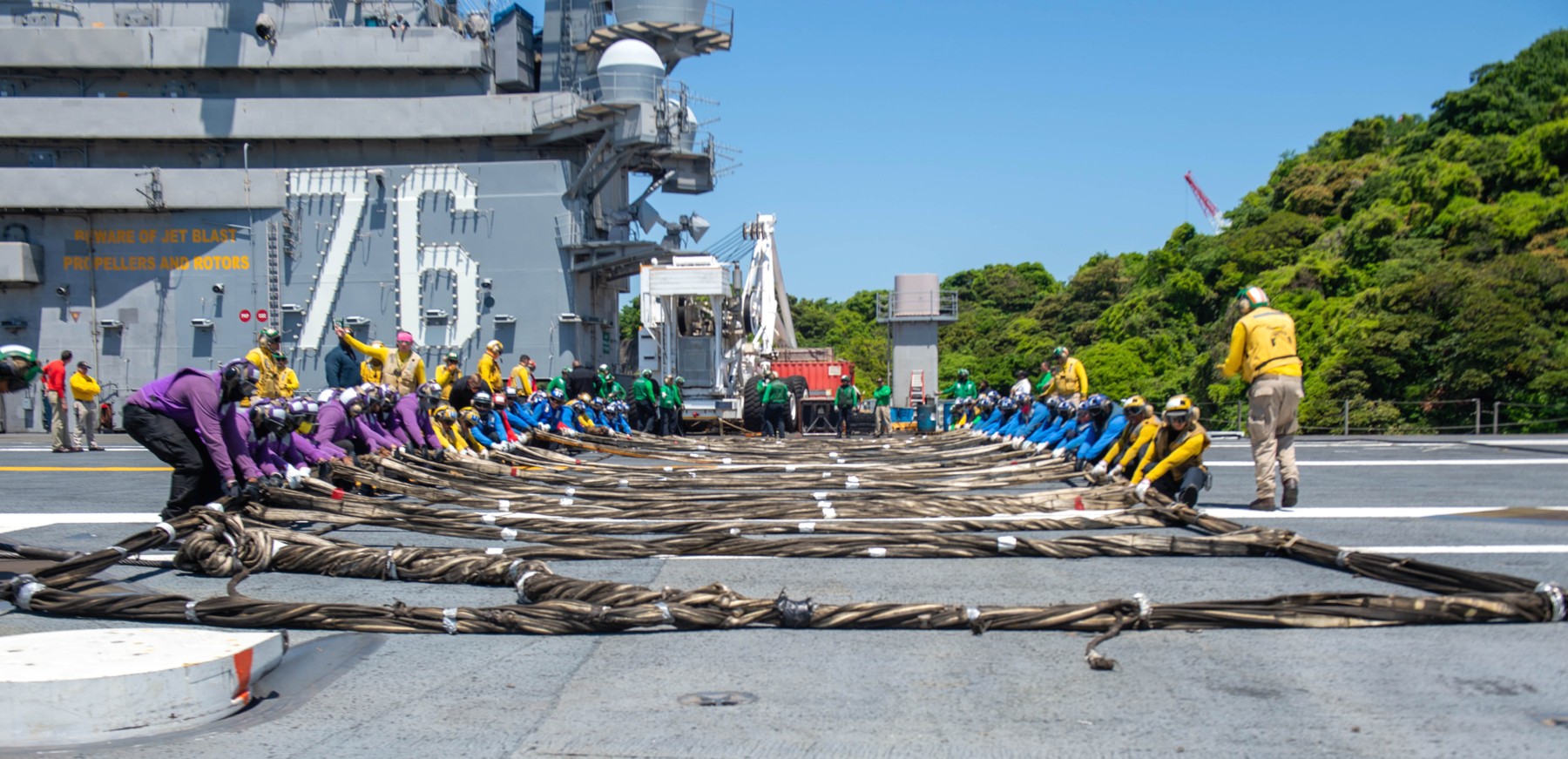 emergency barrier drill - inport Fleet Activities Yokosuka, Japan - May 2024  returning to Fleet Activities Yokosuka, Japan - November 19, 2023  returning to Fleet Activities Yokosuka, Japan - November 19, 2023  with CVW-5 embarked - Pacific Ocean - November 2023  with CVW-5 embarked - Pacific Ocean - November 2023  with CVW-5 embarked - Pacific Ocean - November 2023  with CVW-5 embarked - Pacific Ocean - November 2023  with CVW-5 embarked - Busan, Republic of Korea - October 12, 2023  with CVW-5 embarked - Philippine Sea - October 2023  with CVW-5 embarked - Philippine Sea - October 2023  with CVW-5 embarked - Philippine Sea - October 2023  with CVW-5 embarked - exercise Talisman Sabre - Indian Ocean - July 2023  with CVW-5 embarked - exercise Talisman Sabre - Indian Ocean - July 2023  with CVW-5 embarked - exercise Talisman Sabre - Indian Ocean - July 2023  with CVW-5 embarked - Da Nang, Vietnam - June 25, 2023  with CVW-5 embarked - Da Nang, Vietnam - June 25, 2023  with CVW-5 embarked - South China Sea - June 2023  with CVW-5 embarked - Philippine Sea - June 2023  with CVW-5 embarked - Philippine Sea - June 2023  returning to Fleet Activities Yokosuka, Japan - December 16, 2022  with CVW-5 embarked - Philippine Sea - November 2022  with CVW-5 embarked - Philippine Sea - November 2022  with CVW-5 embarked - Philippine Sea - November 2022  with CVW-5 embarked - Philippine Sea - November 2022  with CVW-5 embarked - off Korea - September 2022  with CVW-5 embarked - off Korea - September 2022  with CVW-5 embarked - off Korea - September 2022  with CVW-5 embarked - off Korea - September 2022  with CVW-5 embarked - 7th Fleet AOR - September 2022  with CVW-5 embarked - Busan, Republic of Korea - September 2022  with CVW-5 embarked - Busan, Republic of Korea - September 2022  with CVW-5 embarked - Philippine Sea - August 2022  with CVW-5 embarked - San Bernardino Strait - July 2022  with CVW-5 embarked - Changi Naval Base, Singapore - July 2022  with CVW-5 embarked - Philippine Sea - June 2022  with CVW-5 embarked - Philippine Sea - June 2022  with CVW-5 embarked - Philippine Sea - June 2022 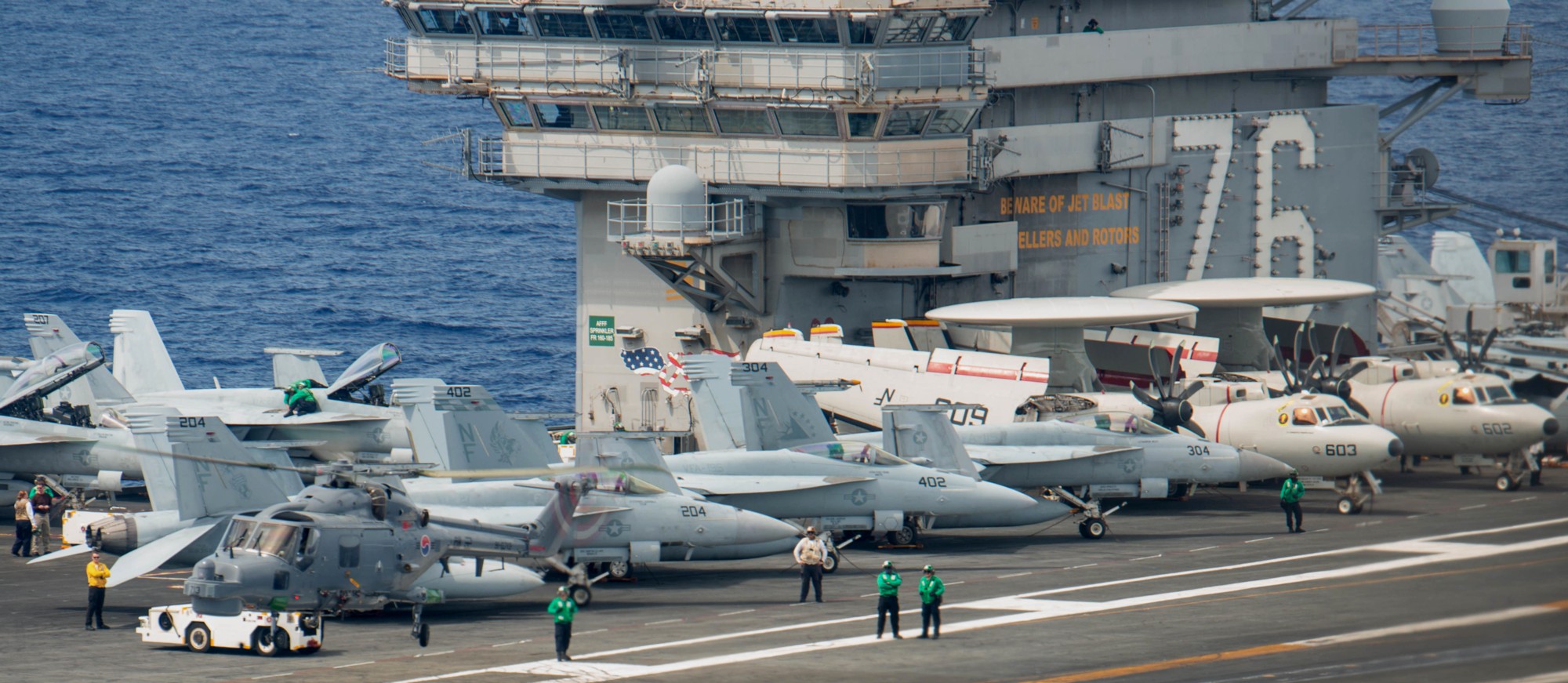 with CVW-5 embarked - Philippine Sea - June 2022  with CVW-5 embarked - off Iwo To (former Iwo Jima) - May 2022  Pacific Ocean - May 2022  Pacific Ocean - May 2022  departing Fleet Activities Yokosuka, Japan - May 2022  departing Fleet Activities Yokosuka, Japan - May 2022  Pacific Ocean - May 2022  Pacific Ocean - May 2022  Pacific Ocean - May 2022  Pacific Ocean - May 2022  returning to Fleet Activities Yokosuka, Japan - October 2021  with CVW-5 embarked - Philippine Sea - September 2021  with CVW-5 embarked - Arabian Sea - September 2021  with CVW-5 embarked - Arabian Sea - September 2021  with CVW-5 embarked - Arabian Sea - September 2021  with CVW-5 embarked - Gulf of Aden - July 2021  Indian Air Force aircraft flyover - Indian Ocean - June 2021  with CVW-5 embarked - Indian Ocean - June 2021  with CVW-5 embarked - Indian Ocean - June 2021  with CVW-5 embarked - Indian Ocean - June 2021  with CVW-5 embarked - South China Sea - June 2021  off Iwo To (former Iwo Jima), Japan - May 2021  off Yokosuka, Japan - May 2021  departing Fleet Activities Yokosuka, Japan - May 2021  returning to Fleet Activities Yokosuka, Japan - November 2020  returning to Fleet Activities Yokosuka, Japan - November 2020  returning to Fleet Activities Yokosuka, Japan - November 2020  with CVW-5 embarked - exercise Keen Sword - October 2020  with CVW-5 embarked - Philippine Sea - September 2020  with CVW-5 embarked - exercise Valiant Shield - Philippine Sea - September 2020  with CVW-5 embarked - exercise Valiant Shield - Philippine Sea - September 2020  with CVW-5 embarked - exercise Valiant Shield - Philippine Sea - September 2020  with CVW-5 embarked - exercise Valiant Shield - Philippine Sea - September 2020  with CVW-5 embarked - Pacific Ocean - September 2020  with CVW-5 embarked - Philippine Sea - August 2020  with CVW-5 embarked - South China Sea - July 2020  with CVW-5 embarked - South China Sea - July 2020  with CVW-5 embarked - Philippine Sea - July 2020  with CVW-5 embarked - Philippine Sea - June 2020  Fleet Activities Yokosuka, Japan - April 2020  with CVW-5 embarked - Coral Sea - August 2019  with CVW-5 embarked - Coral Sea - August 2019  with CVW-5 embarked - Coral Sea - August 2019  with CVW-5 embarked - Coral Sea - August 2019  with CVW-5 embarked - Coral Sea - August 2019  with CVW-5 embarked - Coral Sea - August 2019  with CVW-5 embarked - Coral Sea - August 2019  with CVW-5 embarked - exercise Talisman Sabre - Tasman Sea - July 2019  with CVW-5 embarked - exercise Talisman Sabre - Coral Sea - July 2019  with CVW-5 embarked - exercise Talisman Sabre - Coral Sea - July 2019  with CVW-5 embarked - exercise Talisman Sabre - Coral Sea - July 2019  with CVW-5 embarked - exercise Talisman Sabre - Coral Sea - July 2019  with CVW-5 embarked - exercise Talisman Sabre - Coral Sea - July 2019  with CVW-5 embarked - Philippine Sea - June 2019  with CVW-5 embarked - Philippine Sea - October 2018  with CVW-5 embarked - Philippine Sea - October 2018  with CVW-5 embarked - South China Sea - August 2018  with CVW-5 embarked - South China Sea - August 2018  returning to Fleet Activities Yokosuka, Japan - July 2018  returning to Fleet Activities Yokosuka, Japan - July 2018  with CVW-5 embarked - Philippine Sea - July 2018  with CVW-5 embarked - Philippine Sea - June 2018  with CVW-5 embarked - Philippine Sea - June 2018  departing Fleet Activities Yokosuka, Japan - May 2018  departing Fleet Activities Yokosuka, Japan - May 2018  departing Fleet Activities Yokosuka, Japan - May 2018  departing Fleet Activities Yokosuka, Japan - May 2018  returning to Fleet Activities Yokosuka, Japan - December 2017  returning to Fleet Activities Yokosuka, Japan - December 2017  returning to Fleet Activities Yokosuka, Japan - December 2017  with CVW-5 embarked - Philippine Sea - November 2017  with CVW-5 embarked - Philippine Sea - November 2017  with CVW-5 embarked - Pacific Ocean - November 2017  with CVW-5 embarked - Philippine Sea - November 2017  with CVW-5 embarked - off Korea - October 2017  with CVW-5 embarked - Philippine Sea - September 2017  departing Fleet Activities Yokosuka, Japan - September 2017  returning to Fleet Activities Yokosuka, Japan - August 2017  with CVW-5 embarked - Coral Sea - July 2017  with CVW-5 embarked - Coral Sea - July 2017  with CVW-5 embarked - Coral Sea - July 2017  with CVW-5 embarked - Pacific Ocean - June 2017  with CVW-5 embarked - Pacific Ocean - June 2017  with CVW-5 embarked - South China Sea - June 2017  with CVW-5 embarked - Sea of Japan - June 2017  with CVW-5 embarked - Sea of Japan - June 2017  with CVW-5 embarked - off Japan - May 2017  with CVW-5 embarked - off Japan - May 2017  with CVW-5 embarked - off Japan - May 2017  departing Fleet Activities Yokosuka, Japan - May 2017 > continue - CVN 76 image page 2 < |
||
Ronald Wilson Reagan
 
   with Michail Gorbachev |
||
|
Ronald Wilson Reagan (February 6, 1911 - June 5, 2004)
... was an American politician and actor who served as the 40th President of the United States from 1981 to 1989. Prior to the presidency, he was a Hollywood actor and union leader before serving as the 33rd Governor of California from 1967 to 1975. Reagan was raised in a poor family in small towns of northern Illinois. He graduated from Eureka College in 1932 and worked as a sports announcer on several regional radio stations. After moving to Hollywood in 1937, he became an actor and starred in a few major productions. Reagan was twice elected President of the Screen Actors Guild, the labor union for actors, where he worked to root out Communist influence. In the 1950s, he moved into television and was a motivational speaker at General Electric factories. He was elected Governor of California in 1966. As governor, Reagan raised taxes, turned a state budget deficit to a surplus, challenged the protesters at the University of California, ordered in National Guard troops during a period of protest movements in 1969, and was re-elected in 1970. He twice ran unsuccessfully for the Republican presidential nomination, in 1968 and 1976. Four years later in 1980, he won the nomination. At 69 years, 349 days of age at the time of his inauguration, he became the oldest president-elect to take the oath of office. Reagan faced former vice president Walter Mondale when he ran for re-election in 1984, and defeated him in a landslide with the largest electoral college victory in American history. Soon after taking office, Reagan began implementing sweeping new political and economic initiatives. His supply-side economic policies, dubbed "Reaganomics", advocated tax rate reduction to spur economic growth, economic deregulation, and reduction in government spending. In his first term he survived an assassination attempt, spurred the War on Drugs, and fought public sector labor. Over his two terms, the economy saw a reduction of inflation from 12.5% to 4.4%, and an average annual growth of real GDP of 3.4%. Reagan enacted cuts in domestic discretionary spending, cut taxes, and increased military spending contributed to increased federal outlays overall, even after adjustment for inflation. Foreign affairs dominated his second term, including ending the Cold War, the bombing of Libya, and the Iran-Contra affair. In June 1987, four years after he publicly described the Soviet Union as an "evil empire", Reagan challenged Soviet General Secretary Mikhail Gorbachev to "tear down this wall!", during a speech at the Brandenburg Gate. He transitioned Cold War policy from détente to rollback by escalating an arms race with the USSR while engaging in talks with Gorbachev. The talks culminated in the INF Treaty, which shrank both countries' nuclear arsenals. Reagan began his presidency during the decline of the Soviet Union, and the Berlin Wall fell just ten months after the end of his term. Germany reunified the following year, and on December 26, 1991 (nearly three years after he left office), the Soviet Union collapsed. When Reagan left office in 1989, he held an approval rating of sixty-eight percent. He was the first president since Dwight D. Eisenhower to serve two full terms, after a succession of five prior presidents did not. Although he had planned an active post-presidency, Reagan disclosed in November 1994 that he had been diagnosed with Alzheimer's disease earlier that year. Afterward, his informal public appearances became more infrequent as the disease progressed. He died at home on June 5, 2004. |
||
|
USS Ronald Reagan (CVN 76): USS Ronald Reagan, Capt. James A. Symonds in command, shifted coasts from the Atlantic Fleet to the Pacific Fleet, shortly after her commissioning. The ship, with 15 aircraft embarked: Boeing F/A-18E Super Hornets of Strike Fighter Squadron (VFA) 14, F/A-18Fs of VFA-41, Grumman E-2C Hawkeye 2000s of Carrier Airborne Early Warning Squadron (VAW) 117, and Sikorsky SH-60F Seahawks of Helicopter Antisubmarine Squadron (HS) 6 from Carrier Air Wing (CVW) 11, Capt. James K. Greene in command, together with two Grumman C-2A Greyhounds of Fleet Logistics Support Squadron (VRC) 30, sailed from Norfolk on 27 May 2004. Rear Adm. Robert T. Moeller, Commander Ronald Reagan Carrier Strike Group, and Capt. William P. Hoker, Commander Destroyer Squadron 7, broke their flags in the ship. Ronald Reagan also took part in Summer Pulse 04, a series of exercises in which the Navy tested changes to operational methods that resulted from the Fleet Response Plan. At times aircraft carriers Enterprise (CVN-65), George Washington (CVN-73), Harry S. Truman (CVN-75), John C. Stennis (CVN-74), John F. Kennedy (CV-67), Kitty Hawk (CV-63) also deployed in five theaters. The operations of these ships extended into September during scheduled deployments, surge operations, and joint and international exercises. The carrier buried 11 veterans at sea on 31 May, and crossed the equator on 3 June. President Reagan died on 5 June 2004, and crewmembers honored their ship’s namesake by flying her flag at half-mast and laying a wreath on the flight deck. Capt. Symonds was flown ashore to render honors during the president’s interment service at the Ronald Reagan Presidential Library, Simi Valley, Calif., on 11 June. Symonds presented the national ensign used to cover the president’s casket to Mrs. Reagan. Ronald Reagan meanwhile trained with the Brazilian armed forces, and Brazilian naval Douglas AF-1 (A-4KU) Skyhawks performed “touch and go’s” on board the carrier on 8 June. The ship then visited Rio de Janeiro, Brazil, from 9–13 June. Two days later the ship held a memorial service for her namesake, and began another series of exercises with South American naval forces, from 15–17 June. An Argentinean naval Dassault-Breguet Super Étendard and a Grumman S-2T (S-2E) Turbo Tracker carried out touch and go’s on board Ronald Reagan on 17 June. The carrier passed through the Strait of Magellan from 19–21 June, anchoring at Punta Areanas, Chile, on 20 June. The carrier rendezvoused with guided missile destroyer Benfold (DDG-65) and fast combat support ship Camden (AOE-2) four days later. Ronald Reagan visited Valparaiso, Chile, from 25–29 June, and took part in Silent Forces, a multinational exercise with guided missile cruiser Thomas S. Gates (CG-51), guided missile destroyers Benfold and Mitscher (DDG-57), Camden, the Brazilians, and the Peruvians from 1–5 July. Capt. Greene celebrated Independence Day by marking his 1,200th carrier landing. The ship afterward put into Callao, Peru, 9–13 July, and reached her new homeport of Naval Air Station (NAS) North Island, Calif., on 23 July. The estimated crowd of 5,000 guests who greeted her arrival included Mrs. Reagan, who was flown out to Ronald Reagan and embarked during the ship’s passage into port. “Ronnie would have loved the sight of this great ship coming into his beloved California,” she said of the late President. “I know how proud he was to have this ship named after him, and in my heart I know he’s looking down on us today and smiling.” On 7 November 2004, the Aircraft Intermediate Maintenance Department performed its first at-sea jet engine test on an engine from an F/A-18 Super Hornet. Ronald Reagan made her maiden deployment during a voyage to the Western Pacific, Indian Ocean, and Arabian Gulf, 4 January–6 July 2006. The cruise also marked the first deployment of Grumman Improved Capability III EA-6B Prowlers (of Electronic Attack Squadron (VAQ) 139), and F/A-18C Hornets and F/A-18E Super Hornets of VFAs 22, 25, 113, and 115 equipped with the Remotely Operated Video Enhanced Receiver (ROVER) system. On 3 November 2006, the Naval Air Systems Command announced the planned installation (in 2007) of the Advanced Recovery Control system on board Ronald Reagan. The system replaced mechanical arresting systems and their controls with state-of-the-art arresting gear digital control technology. On 22 October 2007, Santa Ana winds drove 23 wild fires across 12 southern Californian counties. Ships involved in fighting the fires included Ronald Reagan, amphibious assault ships Boxer (LHD-4), Peleliu (LHD-5), and Precommissioning Unit Makin Island (LHD-8), and amphibious transport dock Cleveland (LPD-7). Ronald Reagan stood up her Crisis Response Team, which monitored the situation and kept crewmember’s families informed of the battle against the flames. The ship’s Sailors living in barracks at NAS North Island hurriedly moved back on board to free over 100 rooms for their families displaced by the fires. More than 150 crewmembers volunteered to assist affected communities. In addition, marines evacuated more than 40 aircraft from Marine Corps Air Station Miramar, Calif., and all the armed forces aided civilian firefighters. Commander Maritime Strike Wing Pacific established the Helicopter Coordination Center at NAS North Island. The center coordinated a variety of aircraft including a Lockheed P-3C Orion from Patrol Squadron (VP) 46, MH-60S Seahawks from Helicopter Sea Combat Squadrons (HSCs) 3 and 85, SH-60Fs from HSs 4 and 6, SH-60Bs from Helicopter Antisubmarine Squadron (Light) (HSL) 45, marine Boeing Vertol CH-46E Sea Knights and Sikorsky CH-53E Super Stallions from Camp Pendleton and Miramar, and a Bell UH-1N Iroquois from NAS Fallon, Nev. Other facilities including NAS North Island accommodated evacuees. Responders contained the infernos by 3 November. On 11 February 2008, sailors consigned the ashes of nine Navy veterans including astronaut Capt. Walter M. Schirra to the Pacific, during a ceremony on board Ronald Reagan. While Ronald Reagan steamed in the Western Pacific on 25 June 2008, she supported relief efforts to victims of Typhoon Fengshen on Panay in the Philippines. Sikorsky HH-60H and SH-60F Seahawks from HS-4 flying from the carrier, along with SH-60Bs of HSL-49, embarked on board guided missile cruiser Chancellorsville (CG-62), HSL-43, flying from guided missile destroyer Howard (DDG-83), and HSL-37, deployed with guided missile frigate Thach (FFG-43), delivered food and water to people in the area. Two C-2A Greyhounds from VRC-30 flew rice and water from the carrier to Santa Barbara Airport, Iloilo. Ronald Reagan came about from the Sulu Sea on 3 July. A fire erupted in the aft engine room of Carnival cruise ship Carnival Splendor and she lost power, 150 nautical miles southwest of San Diego, on 8 November 2010. The following day, C-2A Greyhounds of VRC-30 transported supplies from NAS North Island to Ronald Reagan, and HH-60H and SH-60F Seahawks of HS-4 then delivered the provisions to the stricken vessel. A Coast Guard Lockheed HC-130H Hercules, a Eurocopter HH-65C Dolphin, MH-60T Jayhawks, and cutters Aspen (WLB-208), Edisto (WPB-1313), Morgenthau (WHEC-722), and Petrel (WPB-87350) also participated. Tugs towed Carnival Splendor to San Diego. A magnitude 9.0 undersea megathrust earthquake occurred off the Tohoku region of Honshu, Japan, at 1446 on 11 March 2011. The earthquake triggered tsunami waves that reached more than 100 feet in height at places, and caused nearly 25,000 casualties, including more than 15,000 killed. The United States initiated Operation Tomodachi [from the Japanese Tomodachi Sakusen: Operation Friend(s)] to provide humanitarian relief to the victims. When the disaster occurred, Ronald Reagan, Capt. Thom W. Burke in command, was steaming westerly courses during a deployment to the Western Pacific, Indian Ocean, and Arabian Gulf. She made for the affected area, and searched for survivors and launched aircraft that flew humanitarian supplies to victims ashore. While the Military Sealift Command auxiliary dry cargo ship Carl Brashear (T-AKE-7) closed Ronald Reagan during a replenishment, she encountered dangerous debris spread by the tsunamis. “Drifting shipping containers,” Capt. Michael Grogan, her master, succinctly summarized, “are difficult to see.” Ronald Reagan came about from supporting Tomodachi on 5 April and continued her deployment. A total of 24,000 U.S. servicemembers, 189 aircraft, and 24 ships served in Tomodachi, from 12 March - 4 May 2011. On 10 January 2012 Reagan's official home port was changed to Bremerton, Washington, where she stayed for a little over a year until returning to her home port of San Diego on 21 March 2013. For the sailors being relocated, the Navy had many of their vehicles transported on the deck of the ship as a cost-saving measure. On 14 January 2014, the Navy announced that Ronald Reagan would replace her sister ship George Washington as the Seventh Fleet forward deployed carrier at Yokosuka, Japan in 2015. On 1 October 2015, Ronald Reagan arrived in its newest home port, Yokosuka Kanagawa Prefecture, Japan replacing USS George Washington and taking its new place as the flagship of Carrier Strike Group Five and Carrier Air Wing Five (CVW-5). On 4 June 2016, Ronald Reagan left its base in Yokosuka. It was deployed with "Carrier Strike Group 5" to the South China Sea before an international tribunal released its decision regarding a China and Philippines conflict. It returned after a 53-day cruise for a mid-cruise break and conducted Board of Inspection and Survey (INSURV) inspections designed to ensure the ship lasts for its full 50-year lifespan. It temporarily left port due to Typhoon Lionrock. After completing INSERV it returned to sea on September 3. It then participated in Exercise Valiant Shield 2016 before making a port call at Guam, and participating in "Invincible Spirit", a joint exercise with South Korean forces in the Sea of Japan and the Yellow Sea. Ronald Reagan returned to Yokosuka on 21 November. From 10 January 2017, the ship began a period of Selected Restricted Availability with a focus on part of the ship including the flight deck, hangar bays, and general living spaces. On 19 April the ship was visited by Vice President Mike Pence. On 7 May, the ship put to sea for sea trials before her annual patrol. Following a short period of sea trials, Ronald Reagan returned to port, then left again on her annual cruise on 16 May, to relieve her sister ship Carl Vinson, which had been deployed near North Korea in light of political tensions. She visited Singapore in June and then sailed to Australia where she participated in Exercise Talisman Saber with Australian and other forces in July. She then made a port visit to Brisbane before returning to Japan on 9 August. On 8 September she departed Yokosuka again to conduct patrols off Korea after the North Korean missile launch over Japan and nuclear test. On 2 October the ship visited Hong Kong. She then participated in drills with the Japan Maritime Self-Defense Force off Okinawa. After that, Ronald Reagan participated in drills off the Korean peninsula with the South Korean Navy. After the drills, she made a port visit at Busan in South Korea. On 29 October 2017, Ronald Reagan scrambled an undisclosed number of Super Hornets to intercept two Russian Tu-95MS bombers on a Tokyo Express flight near Japan that were heading towards the carrier. The Russian bombers were accompanied by their own Su-35S escort fighters. During their flights the bombers were also intercepted by F-2, F-4 and F-15 fighters of the Japan Air Self-Defense Force. In November destroyers assigned to Ronald Reagan conducted exercises with the Indian Navy after which the Indian Navy ships and a Japan Self-Defense Forces destroyer conducted exercises with Ronald Reagan. Later in November 2017 the vessel conducted drills with two other US aircraft carriers, Nimitz and Theodore Roosevelt. It was the first time in a decade that three US carrier strike groups had operated together in Asia. They were also joined by the Japanese helicopter destroyer Ise and the guided missile destroyers Inazuma and Makinami. After working with the Japanese warships the carrier groups conducted drills with seven South Korean vessels, including two Aegis-equipped destroyers. The drills were timed to coincide with the Asian tour of US President Donald Trump amid tensions with North Korea. On 22 November 2017, a C-2A Greyhound cargo plane of VRC-30 with 11 crew and passengers aboard crashed into the Philippine Sea 145 km northwest of Okinotorishima while flying from Marine Corps Air Station Iwakuni to the carrier. It was the first C-2 loss since 2005, and the first fatal crash since 1973. Eight of the 11 were rescued. Ronald Reagan returned to Yokosuka on 4 December. From 17 May 2018 Ronald Reagan conducted sea trials, and on 28 May 2018 she departed on her regular patrol of the Pacific. Her departure was several weeks late. The delay was caused by a "material issue" that required repairs discovered during the sea trials. Field Carrier Landing Practice for aircrew on Iwo Jima were also delayed. After patrolling through the disputed South China Sea, the ship visited the Philippines for the first time, and stayed for four days. From 7 to 16 June 2018 the carrier participated in the Malabar 2018 exercise with Japan and India near Guam. Ronald Reagan returned to Yokosuka on 24 July. On 27 July along with other vessels she left port again to avoid Typhoon Jongdari, returning on 30 July. She left port again ahead of a typhoon on 7 August. On 31 August 2018, the carrier conducted training with the Izumo-class helicopter destroyer Kaga, of the Japan Maritime Self-Defense Force. On 21 November 2018, the ship visited Hong Kong. The ship backfitted the existing AN/SPS-48E three-dimensional (3D), air search radar with the AN/SPS-48G. On 24 August 2019, Ronald Reagan returned to Yokosuka Naval Base, after a very short patrol of the western Pacific. The vessel made two stops over the deployment. First at Brisbane, Australia, to join in the Talisman Sabre 2019 war games off Australia's east coast, then at Manila, Philippines for a brief port visit. The ship also participated in several exercises at sea with partner nations, most recently with the Japan Maritime Self-Defense Force. The coronavirus pandemic was reported to have spread to Ronald Reagan when the first two cases were reported on 27 March 2020. The positive cases forced the closure of the naval base outside Tokyo where the carrier is based, with all personnel on base told to stay indoors for 48 hours. On 5 July 2020, the Ronald Reagan Carrier Strike Group was deployed to the South China Sea along with USS Nimitz. On 26 June 2021, Ronald Reagan was deployed to the Middle East to help with the withdrawal of US troops from Afghanistan. In late May 2022, Ronald Reagan was relieved by USS Abraham Lincoln at Sasebo, Japan. Ronald Reagan led Carrier Strike Group 5 into the Philippine Sea. On 4 August 2022, United States National Security Council spokesman John Kirby announced that Ronald Reagan had been ordered to remain in the vicinity of Taiwan in response to missile launches conducted by China, which in turn were a response to Speaker of the United States House of Representatives Nancy Pelosi's visit to Taiwan. On 19 August 2022, Ronald Reagan returned to her home port of Yokosuka, Japan. On 12 September 2022, Ronald Reagan departed Yokosuka for the second leg of her regional patrol. Ronald Reagan arrived at Busan, South Korea for a scheduled port visit on 23 September 2022. This was the first time in four years that a US Navy aircraft carrier had visited South Korea. In April 2023 the Commander, Naval Air Forces announced that USS George Washington would again be homeported at Fleet Activities Yokosuka in Japan and would relieve Ronald Reagan beginning in 2024. Ronald Reagan will depart Yokosuka and relocate to Bremerton, Washington, to conduct a scheduled Drydocking at Puget Sound Naval Shipyard. On 25 June 2023, Ronald Reagan and two escort cruisers, Antietam and Robert Smalls, made a port call in Tien Sa port in Da Nang, Vietnam and remained until 30 June. This is the third visit a US carrier has made to Vietnam since 2018, with another visit occurring in 2020. In May 2024, the ship left Yokosuka for her final patrol as the US Navy's only forward deployed carrier in advance of her homeport change to Naval Base Kitsap, Bremerton, Washington. source: US Naval History & Heritage Command + wikipedia |
||
| patches + more | ||
 |
||
| | seaforces.org | USN ships start page | |
